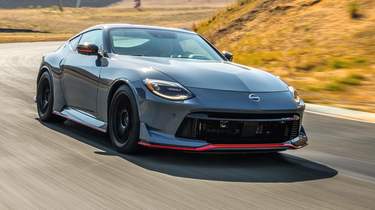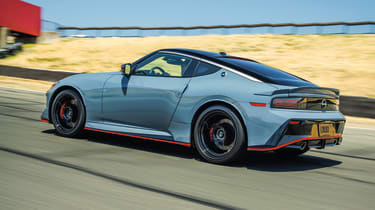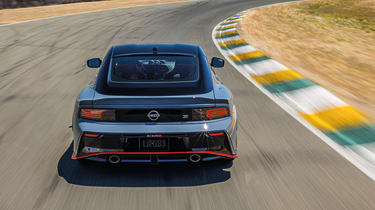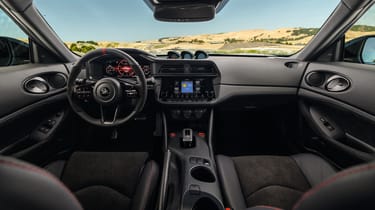Nissan Z Nismo 2024 review – Japan's answer to the BMW M2
The latest Z car has had a Nismo makeover, with a reworked chassis and aero, more power – and an auto ’box. It’s still not coming to Europe, but are we missing out?
The Nissan Z arrived in 2022 with barely a murmur. After a mini furore surrounding the Z Proto concept in 2020 – a time when any diversion was welcome – the production model seemed to arrive and then disappear into the ether. Some of that can be attributed to the fact that the cool new 3-litre twin-turbocharged V6 coupe wasn’t destined for Europe, but even when we visited the US nobody seemed to be talking, thinking or dreaming of the new 400bhp Nissan Z. The general consensus was curt and slightly devastating. ‘Not as good as a Supra’ just about covered it.
Well, now there’s a hotter and, according to Nissan, ‘track-ready’ Z deserving of our attention. It’s called the Z Nismo and has a lot of the right stuff. Compared with the standard car there’s only slightly more power – 420bhp at 6400rpm, with 384lb ft of torque (up 34lb ft) from 2000 to 5200rpm – but the cooling, chassis, aero and braking are completely reworked. Nissan claims the much bigger front splitter and canards combine with a larger rear spoiler and redesigned rear bumper to create downforce, plus there are some delightfully geeky but highly niche declarations, including that the Z Nismo uses ‘the thinnest honeycomb mesh of any Nissan production car’ for its grille to reduce drag and improve cooling.
More reviews
Group tests
- Lotus Emira Turbo SE v Alpine A110 GTS – two of the last surviving mid-engined sports cars
- Alpine A290 v Alpine A110 – how much DNA do they really share?
- Ariel Atom 4R v Caterham Seven ‘evo25’: power-to-weight heroes go head-to-head
- Ariel Atom 4 v Caterham Seven 310R v Lotus Elise Cup 250
- £200,000 supercar shoot-out: AMG v Aston Martin v Maserati v McLaren
- Audi Quattro, RS2 and RS3: five-cylinder icons head-to-head
- Who makes the best GT car? Aston Martin v Bentley v Maserati
- Caterham Super Seven 600 v Super Seven 2000
- Corvette Stingray v Porsche Cayman GTS v Audi R8 RWD
- Great Ferrari hypercars driven: 288 GTO, F40, F50 and Enzo head-to-head
In-depth reviews
- Abarth 600e 2025 review – Italy gives the Alpine A290 something to worry about
- Alpine A110 review – the sports car Lotus should be building
- Aston Martin Vantage 2025 review – a thrilling Mercedes-AMG GT and 911 Turbo S alternative
- Audi R8 (2015 - 2024) review – the ultimate soft-focus supercar
- Bentley Flying Spur review – the ultimate driver’s limousine
Long term tests
- Abarth 695C Turismo Fast Fleet test – living with the charming Italian hatch
- Alfa Romeo Giulia Veloce long term test – can Italy beat Germany?
- Aston Martin Vantage (2006) Fast Fleet test – living with a £30k V8 Aston
- Caterham Seven evo25 Fast Fleet test – living with a track car for the road
- Caterham Seven evo Edition revealed – bespoke 420R joins the Fast Fleet
- Cupra Leon 300 Fast Fleet test – living with Spain's 300bhp hot hatch
- Cupra Ateca VZN Fast Fleet test – four months with Cupra's hot crossover
- Cupra Leon Estate 310 4Drive Fast Fleet test – living with the 306bhp hot estate
- Ford Mustang GT
- Ford Mustang GT
Review
- New Bentley Batur 2023 review – can it possibly be worth £1.65m?
- 2023 Chevrolet Corvette C8 Z06 review – the American 911 GT3?
- BBR Supercharged Mazda MX-5 (ND) 2023 review – tuned 250bhp roadster driven
- MG4 Trophy 2023 review
Reviews
- Abarth 695 75 Anniversario edition 2024 review – a fitting send-off for Abarth’s hot supermini?
- Abarth 500e 2023 review
- AC Cobra 378 Superblower MkIV 2021 review – another V8 Cobra, but with a GM heart this time
- Acura Integra Type S 2024 review – a Honda Civic Type R with added restraint
- Alfa Romeo Giulia review – get one while you still can
- Alfa Romeo 33 Stradale 2025 review – a rare Italian jewel beyond compare
- Alfa Romeo SZ: history, review and specs of an icon
> The Nissan Safari Rally Z is what an affordable Porsche 911 Dakar could look like
Refreshingly, the Nismo uses fixed-rate dampers. The bodies of these are bigger to improve consistency of performance and they’re more aggressive than those of the standard car. There are also revised anti-roll bars, stiffer springs and modified bushings for greater accuracy and control. The tyres are excellent Dunlop SP Sport Maxx GT600s (as used on the GT‑R) and the Z has a pretty decent footprint with 255/40 R19s and 285/35 R19s fitted front and rear respectively. Brakes are by Akebono with four-piston calipers on the front paired with 381mm discs, and a two-piston set-up at the rear with 350mm discs. The chassis also features additional bracing with front and rear strut braces and underfloor enhancements, too. Like I said, all the good stuff.
The bad stuff is potentially fatal, however. Firstly, the Z Nismo is heavier than the standard car, which was already heavier than the pretty tubby 370Z that it replaced. Rather incredibly, this simple front-engine, rear-drive two-seater coupe comes in at 1680kg. Not actually that far off the heinously complex oversized, four-wheel-drive 2+2 that Nissan also makes and isn’t exactly known for its Lotus-like qualities. The next issue is that the Nismo, which on paper could be the slightly old-school, roughneck driver’s car we all crave, is only available with a nine-speed automatic gearbox.
This is a frankly baffling decision. Especially when you consider that the standard car is available with a six-speed manual ’box and the modestly increased power and torque don’t appear to be the deciding factor behind this strategy. Nissan actually went with the auto as it felt buyers would be intensely focused on lap times and so saving a few tenths was worth the price of foregoing the satisfaction of a manual gearshift. With a Porsche GT3 RS this is a reasonable conclusion to reach. But when developing a slightly more focused version of a traditional sports car platform with its roots very much in everyday fun? It seems almost a dereliction of duty. In the US, there has also been some outrage over the ‘sticker price’ of $64,990. That’s more than the new, similarly track-biased, 500bhp Mustang Dark Horse or a 3-litre Toyota Supra (382bhp in US form), and about comparable with a BMW M2.
Despite these misgivings, and the fact that the latest Z car shares so much with the ancient 370Z beneath the skin, I find the Nismo an exciting prospect. To me it looks fantastic and whilst I accept that it’s built on the bones of an old car, the idea of a brawny, rear-drive coupe with more than one eye on track performance and a bit of Nismo fairy dust sprinkled liberally on top sounds deeply appealing. It’s very easy to throw stones at the Z, but as a more exotic M2 rival that’s slightly lighter (absurd but true), much more cohesive in terms of design and isn’t trying to be all things to all people through a million different driver modes, it could hit an unlikely sweet spot. Let’s see…
My first impressions of the car are on the West Circuit of California’s Thunderhill Raceway. It’s not exactly Spa but the two-mile configuration packs plenty of varying challenges. There are two very fast chicanes, some nice elevation changes, a lovely off-camber blind right that’s not quite flat, and not too much scope for absolute disaster in the run-off areas. So I click the drive mode up from Standard, through Sport and into Sport+. This essentially works on the engine response, gearbox programming, steering, stability control and sound, as the dampers are fixed. Nissan says it’s quicker with the ESC in Sport+ mode than disengaged entirely.
Before I even roll into the pitlane the Nismo feels about as I’d hoped. Despite carry-over architecture from the 370Z the environment is just fresh enough. The displays and overall feel are certainly a generation or two behind, say, the latest M2, but I’m not so sure that’s a bad thing. There are some slightly cheap-feeling plastics and the stalks are very 350Z, but the touch points that count are Alcantara-trimmed, the Recaro seats offer great support and the driving position is excellent. The 3-litre twin-turbo V6 starts with a familiar big-lunged noise but immediately it feels smoother than the characterful but coarse naturally aspirated engine of the 370Z. Rolling out onto the circuit the steering is quite heavy but feels very taut in its responses and the chassis has a lovely oiled-yet-tight feeling. Already it feels sharper than any Z car I can remember.
As the circuit unravels, the gearbox is a bit of a frustration. Despite being upgraded with unique clutch packs and new software that’s said to reduce shift times by 50 per cent, the ’box isn’t a match for the M2’s automatic, let alone a really good dual-clutch set-up. In manual mode it requires anticipation on upshifts to avoid hanging on the limiter and downshifts never quite arrive when you ask. Perhaps this could be masked if the engine was sharp and intense, but it’s actually rather forgettable. The brawny feel at idle and low speeds never quite transforms into a fiery, energetic delivery. The Z Nismo is fast but the turbocharged V6 doesn’t crackle with excitement. Oh dear. Is the Z about to show me why it disappeared into nothingness back when the standard car was launched?
The answer is, surprisingly, a resounding no. For whilst the engine and gearbox are effective rather than inspirational, the chassis balance, braking, steering and the ability to overlap so many different requirements is top notch. The Z Nismo is rather brilliant on a track. It instils immediate confidence thanks to the steering – which is perhaps a shade too weighty but feels so well located (the steering rack has stiffer bushes) and offers an unhurried, measured accuracy. Those GT‑R-style tyres have tremendous bite and the Nismo has a fine balance between urgency and control. An M2 is more responsive but then folds into understeer more quickly or, more likely, lights up into oversteer. The Nissan is certainly more calculated and a little less exciting, but such is the grip that you can really attack the racetrack and reach for every bit of power available. So the experience starts out as smooth and perhaps a little too controlled, but it can ramp up quickly, right to the point where you’re really punching in steering inputs and braking late and deep with minimal delay before getting back on the power.
The really impressive thing is that the Nismo rarely gets wrong-footed. It soaks up kerbs in one fluid bite, the brakes remain consistent and there’s so much traction to lean on. Of course, you can make the Nismo slide in the old Z-car ways, but it prefers to be driven pretty neatly, with just a small amount of angle on corner exit and without the rear tyres spinning up too much faster than road speed. Perfect for trackdays where lurid angles will quickly get you black-flagged. The traction control is also expertly calibrated and – as promised and rather depressingly – is able to deliver slightly quicker laps than driving completely unassisted, unless you have the touch of Charles Leclerc. It really does feel like a very well-sorted and brilliantly optimised platform with a lovely consistency to all of its controls and an addictive balance.
On the road, much of the good stuff remains and some of it is amplified. The steering, ride quality and body control once again take centre stage and the Z Nismo feels polished but with just enough edge to ensure it’s exciting even at low speeds. Sadly, the engine is a constant source of, well, not much. It’s a power unit but never really rises up to make itself a thrilling part of the package. The automatic gearbox, if anything, is more annoying. Simply put it inserts a fuzzy, slightly inconsistent layer between driver and car that seems all the more tragic when you’re not enjoying the full potential of what the chassis can offer. It’s crying out for a manual gearbox or even a super-sharp dual-clutch system.
So, the Nissan Z Nismo is in parts superb, in parts deeply frustrating, but overall an intriguing and impressive proposition. It doesn’t quite fizz with energy, which is certainly in part due to the weight it’s carrying, nor does it feel as fast as a BMW M2 or as nimble as a Porsche 718 Cayman. However, it counters with excellent composure and balance, a bit of Japanese oddness mixed with some California cool, and there’s almost a restomod-style appeal, too. Far from its ageing roots being a hindrance, I can’t help but think they’re something of a bonus. The Z Nismo is a six-speed manual ’box away from being really rather special. Remember how Toyota listened and gave us a manual Supra? Nissan, now it’s your turn…
Nissan Z Nismo specs
| Engine | V6, 2997cc, twin-turbo |
| Power | 420bhp @ 6400rpm |
| Weight | 1680kg (254bhp/ton) |
| Torque | 384lb ft @ 2000-5200rpm |
| 0-62mph | 4.5sec (est) |
| Top speed | 157mph |
| Basic price | $64,990 |
This story was first featured in evo issue 319.




